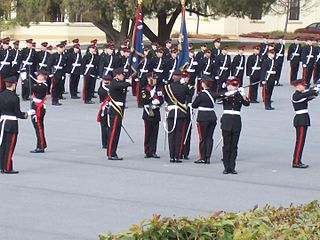
A military academy or service academy is an educational institution which prepares candidates for service in the officer corps. It normally provides education in a military environment, the exact definition depending on the country concerned.

The Soviet Air Forces (Russian: Военно-Воздушные Силы Союза Советских Социалистических Республик, tr.Voenno-Vozdushnye Sily Soyuza Sovetskih Sotsialisticheskih Respublik, VVS SSSR; literally "Military Air Forces of the Union of Soviet Socialist Republics"; initialism VVS, sometimes referred to as the "Red Air Force", were one of the air forces of the Soviet Union. The other was the Soviet Air Defence Forces. The Air Forces were formed from components of the Imperial Russian Air Service in 1917, and faced their greatest test during World War II. The groups were also involved in the Korean War, and dissolved along with the Soviet Union itself in 1991–92. Former Soviet Air Forces' assets were subsequently divided into several air forces of former Soviet republics, including the new Russian Air Force. The "March of the Pilots" was its marching song.

Russia has a number of military academies of different specialties. This article primarily lists institutions of the Armed Forces of the Russian Federation rather than those of the Soviet Armed Forces.
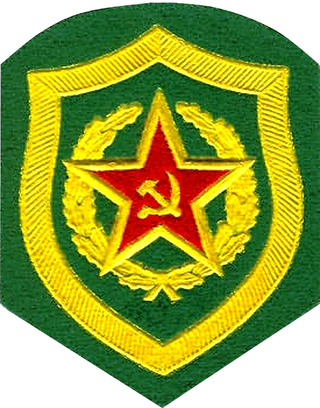
The Soviet Border Troops were the border guard of the Soviet Union, subordinated to the Soviet state security agency: first to the Cheka/OGPU, then to NKVD/MGB and, finally, to the KGB. Accordingly, they were known as NKVD Border Security and KGB Border Troops. Unlike the border guards of many other countries, Soviet Border Troops also included the maritime border guarding units, and aviation units.

The Suvorov Military Schools are a type of boarding school in the former Soviet Union and in modern Russia and Belarus for boys of 10–17. Education in these schools focuses on military related subjects. The schools are named after Alexander Suvorov, a well-known 18th century Russian general.

Andrey Nikiforovich Vitruk was a Soviet military officer, a Major General of the Soviet Air Forces and a Hero of the Soviet Union.
This is a glossary of acronyms and initials used for organisations in the Russian Federation and formerly the USSR. The Latin-alphabet names are phonetic representations of the Cyrillic originals, and variations are inevitable.

The Combined Arms Academy of the Armed Forces of the Russian Federation is a military academy in Moscow which provides graduate education for officers of the Russian Armed Forces. The full name reads: The Combined Academies Order of Lenin Order of the October Revolution Red Banner Order of Suvorov of the Armed Forces of the Russian Federation-Military Educational and Scientific Center of the Russian Ground Forces.

The Saint Petersburg Military Engineering-Technical University (Nikolaevsky), previously known as the Saint Petersburg Nikolaevsky Engineering Academy, was established in 1810 under Alexander I. The university is situated in the former barracks of the Cavalier-Guard Regiment where the university was founded.

The Serdyukov reform, named after its originator, Defence Minister Anatoly Serdyukov, was a major structural reorganisation of the Russian Armed Forces that began in 2009.

The 2000 Moscow Victory Day Parade was held on 9 May 2000 to commemorate the 55th anniversary of the capitulation of Nazi Germany in 1945. The parade marks the Soviet Union's victory in the Great Patriotic War.

The M. V. Frunze Military Academy, or in full the Military Order of Lenin and the October Revolution, Red Banner, Order of Suvorov Academy in the name of M. V. Frunze, was a military academy of the Soviet and later the Russian Armed Forces.

The National Defence University of Ukraine (NDUU) is a university of higher military education in Ukraine, located in its capital city of Kyiv. Subordinated to the Ministry of Defence of Ukraine, the University trains officers specializing in national defence.

Military Academy of the Republic of Belarus is higher military educational institution in the national education system of the Republic of Belarus and the leading institution in the education system of training, retraining and advanced training of military personnel. It is located on Independence Avenue in the Belarusuan capital of Minsk. It has 10 departments that train officers of 38 specialties for all arms of service.
The Riga Civil Aviation Engineers Institute (RCAEI) (Latvian: Rīgas Civilās Aviācijas Inženieru Institūts (RCAII), Russian: Рижский институт инженеров гражданской авиации (РКИИГА until 1991), Рижский авиационный университет (РАУ until 1999)) was an engineering university in the USSR and Latvia. It was founded in 1919 and closed in 1999. Thousands of students graduated from the institute from over 93 countries. The institute had several different names during its history as well as moving from Kiev to Moscow to Petrograd to Riga. Riga Aviation University closed in 1999, with its programmes moved to Riga Technical University.
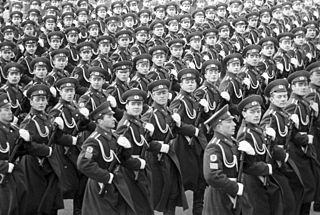
The 1972 October Revolution Parade was held in commemoration of the 55th anniversary of the 1917 October Revolution and the 50th anniversary of the founding of the Soviet Union in 1922. Notable attendees were Soviet General Secretary Leonid Brezhnev and Soviet Prime Minister Nikolai Podgorny. The parade's commander was Colonel General Vladimir Govorov, the Commander of Troops of the Moscow Military District, while its presiding officer was Marshal of the Soviet Union Andrei Grechko.
The 1989 October Revolution Parade was a parade that took place in Red Square in Moscow on 7 November 1989 to commemorate the 72nd anniversary of the socialist revolution in the Russian Empire in 1917. Mikhail Gorbachev and the Soviet leadership watched the parade from Lenin's Mausoleum. General of the Army and Minister of Defence Dmitry Yazov made his third holiday address to the nation after he inspected seven sets of armed battalions and academies. Col. Gen. Nikolai Kalinin the head of the Moscow Military District was the 1989 parade commander.
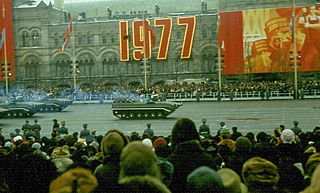
The 1977 October Revolution Parade was a military parade that took place in the Red Square in Moscow on 7 November 1977 to commemorate the 60th anniversary of the October Revolution. The annual parade marks the protest of the Bolsheviks against the Tsarist autocracy of the Russian Empire. The Soviet Communist Party General Secretary Leonid Brezhnev and Soviet Prime Minister Alexei Kosygin attended the parade, among other foreign leaders from Warsaw Pact and allied countries who decided to fly in for the celebrations. Marshal Dmitry Ustinov delivered his second holiday address to the Soviet people on this day, right after the parade inspection that had been presided over by him and led by the commander of the Moscow Military District Colonel General Vladimir Govorov. Music was performed by the Combined Military Band of the Moscow Garrison conducted by Colonel Nikolai Mikhailov. As per tradition, 14 other Soviet Cities held their parades on this day. A folding stock version of the AK-47 appeared in the contingent of troops from the Soviet Airborne Forces. This parade included the updated anthem of the Soviet Union.
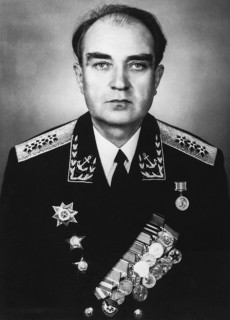
Emil Nikolayevich Spiridonov was an officer of the Soviet Navy. He rose to the rank of admiral and was commander of the Pacific Fleet, before his death in the 1981 Pushkin Tu-104 crash, which also killed many of the Fleet's senior officers.
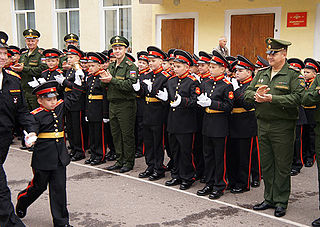
Russian military-focused secondary schools are usual secondary schools conducting secondary general education programme (level 3 according International Standard Classification of Education. They provide their pupils with training in additional military-focused subjects. These schools don't prepare military personnel, and their graduates can choose either military or civilian way of life. These schools include: the Suvorov Military Schools, the Nakhimov Naval Schools and the Presidential Cadet Schools.




















